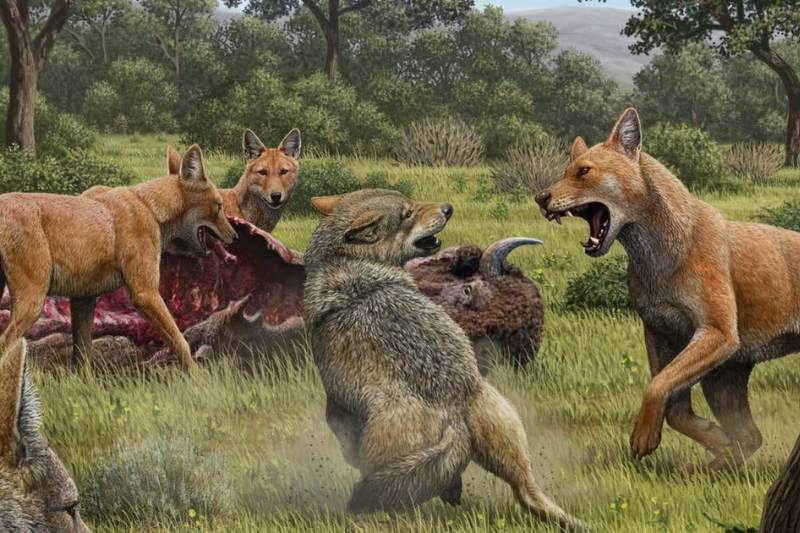
A creature once thought lost to time is now howling again. Thanks to breakthroughs in biotechnology, dire wolves—the legendary predators of the Ice Age—have been brought back to life. This stunning achievement was made possible by Colossal Biosciences, a company pioneering the field of de-extinction.
For over 13,000 years, the dire wolf was nothing more than a fossilized relic.
Now, with ancient DNA extracted from preserved remains, scientists have reconstructed their genetic blueprint. These efforts made dire wolves brought back to life a stunning reality. By comparing their DNA to that of the modern wolf, researchers identified critical traits that made the dire wolf a distinct species.
Once believed to be a subspecies of the gray wolf, recent genetic studies revealed that the extinct dire wolf was, in fact, an entirely separate branch of the canine family tree.
This makes its revival all the more remarkable—scientists didn’t just clone a wolf. They recreated a long-lost predator from the Ice Age.
The company behind this historic project, Colossal Biosciences, was co-founded by Ben Lamm, a tech entrepreneur with a passion for conservation innovation.
With backing from major investors, Colossal aims to resurrect extinct species, not just for spectacle, but to repair ecological damage and support endangered wildlife through genetic diversity.
The first dire wolf puppies, named Romulus and Remus, were born in late 2024 after years of meticulous genetic engineering.
Raised in a wildlife sanctuary, the pups are thriving. Observers say they show classic direwolf behaviors—pack bonding, strong prey drive, and social intelligence.
Their birth is symbolic, not only referencing ancient Roman mythology but also heralding the rebirth of direwolves after millennia of extinction.
The process started with recovered dire wolf DNA, which scientists compared to gray wolves and other canids. Using CRISPR gene-editing, they modified wolf embryos to include the dire wolf’s physical and behavioral traits.
These embryos were implanted into surrogate wolf-dogs, resulting in the first successful dire wolf brought back from extinction.
It’s not a clone—it’s a genetic hybrid, with over 90% of its DNA matching that of the original species.
The direwolf’s return is part of a much bigger mission: to restore biodiversity and stabilize ecosystems destabilized by human activity.
By bringing back apex predators like the dire wolf, scientists hope to improve food chain balance in select regions.
It’s similar to how wolves were reintroduced into Yellowstone, restoring entire ecosystems by managing prey populations.
Ben Lamm believes in using technology not to dominate nature, but to help restore it. His company isn’t stopping at dire wolves. It’s also working on reviving the woolly mammoth, a project expected to result in a live calf by 2028.
The idea is to bring mammoths back to the Arctic tundra, where they could help slow permafrost melt by trampling snow and maintaining cold soil layers.
Like the dire wolf, the woolly mammoth holds the potential to be more than just a symbol of de-extinction. It could become a vital part of our climate resilience strategy.
Colossal Biosciences is working with conservationists and climate scientists to ensure that these revivals are thoughtful, ethical, and sustainable.
Not everyone is cheering. Critics worry that bringing dire wolves back might upset existing ecosystems or lead to unintended consequences.
Colossal, however, says all trials are being conducted in controlled environments. The current focus is not on wild release, but on understanding biology, behavior, and long-term impact.
The birth of the first dire wolf puppies is not just about nostalgia or scientific bravado. It's a look into what may become a new era of conservation.
The wolf, long demonized and misunderstood, is now a genetic gateway into a future where extinction isn’t permanent—and where ancient species might walk beside us once more.
The dire wolf brought back to life isn’t just a scientific success. It’s a cultural moment.
It challenges us to think differently about extinction, technology, and our role in the natural world.
Romulus and Remus are more than pups. They are pioneers—living symbols of what’s possible when curiosity, innovation, and ethics come together.
And somewhere, deep in the forest, the howl of a direwolf echoes again.